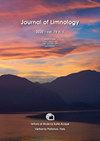Environmental concerns about the effects of effluents from wastewater treatment plants in tourist areas of the Alps: toxicity in aquatic microorganisms
IF 1.1
4区 环境科学与生态学
Q4 LIMNOLOGY
引用次数: 0
Abstract
Are the effluents of wastewater treatment plants in high mountains of concern for aquatic biodiversity? To answer this question, we carried out an experimental study testing the short-term toxicity of some Pharmaceutical Active Compounds (PhACs) in the effluents of a plant in a mountain valley of the Italian Alps sampled during the high tourist season (i.e., the ski season) when PhACs contamination is higher. We used different tools, taking as a model the bacterium Aliivibrio fischeri: the “whole-mixture approach” (Microtox test), “component-based approach”, predictive models “Concentration Addition (CA)”, “Independent Action (IA)”, and Combination Index (CI)”. We investigated the nature of interactions potentially occurring among seven selected PhACs (clarithromycin, naproxen, acetaminophen (paracetamol), ibuprofen, diclofenac, carbamazepine, and amoxicillin). This study showed that anti-inflammatory ibuprofen and diclofenac have higher short-term toxicity (IC50 <100 mg L-1) for A. fischeri compared with antibiotics, whose toxic effects are expected to become visible in the long term. Furthermore, based on the CI method, the seven PhACs seem not to interact in a synergistic or antagonistic way, but the final effect of their mixture seems to be equal to the sum of their individual effects. Notwithstanding the high tourist pressure, the Microtox test reported an overall toxicity of only 21%, which drops to 7% in the receiving water body, the Vermigliana stream. These values, besides the predictions by CA and IA, are not alarming per se, i.e., the treated effluent of the plant in the period of maximum tourist pressure can be considered no harmful to aquatic microorganisms. However, based on other studies highlighting negative effects of the diluted treated effluent of the same plant on macroinvertebrate community structure, we suggest that other model organisms be considered, including algae, insects, and fish, to assess the real ecological risk to wildlife of an effluent. The experimental tests on A. fischeri are useful for fast, preliminary information on the level of risk for freshwater ecosystems, but they should be combined with field studies and experiments on the wild populations to increase the ecological realism.阿尔卑斯山旅游区废水处理厂废水影响的环境问题:水生微生物的毒性
高山上污水处理厂的流出物是否会影响水生生物多样性?为了回答这个问题,我们进行了一项实验研究,测试了在旅游旺季(即滑雪季节),PhACs污染较高的意大利阿尔卑斯山山谷中一家工厂流出物中某些药物活性化合物(PhACs)的短期毒性。我们采用不同的工具,以费氏弧菌为模型:“全混合法”(Microtox测试)、“基于成分的方法”、“浓度加法(CA)”、“独立作用(IA)”和“组合指数(CI)”预测模型。我们调查了七种选定的phac(克拉霉素、萘普生、对乙酰氨基酚、布洛芬、双氯芬酸、卡马西平和阿莫西林)之间可能发生的相互作用的性质。本研究表明,与抗生素相比,抗炎布洛芬和双氯芬酸对菲氏弧菌具有更高的短期毒性(IC50 <100 mg L-1),其毒性作用预计在长期内会显现出来。此外,基于CI方法,七种phac似乎不以协同或拮抗的方式相互作用,但它们混合的最终效果似乎等于它们各自作用的总和。尽管游客压力很大,但Microtox测试报告的总体毒性仅为21%,在接收水体Vermigliana溪流中下降到7%。除了CA和IA的预测外,这些值本身并不令人担忧,即在最大游客压力期间,工厂处理过的废水可以被认为对水生微生物无害。然而,基于其他研究强调了同一植物的稀释处理废水对大型无脊椎动物群落结构的负面影响,我们建议考虑其他模式生物,包括藻类,昆虫和鱼类,以评估废水对野生动物的真正生态风险。对菲氏弧菌的实验测试有助于快速、初步地了解淡水生态系统的风险水平,但应将其与野外种群的实地研究和实验相结合,以增加生态真实性。
本文章由计算机程序翻译,如有差异,请以英文原文为准。
求助全文
约1分钟内获得全文
求助全文
来源期刊

Journal of Limnology
地学-湖沼学
CiteScore
2.70
自引率
6.20%
发文量
12
审稿时长
3 months
期刊介绍:
The Journal of Limnology publishes peer-reviewed original papers, review papers and notes about all aspects of limnology. The scope of the Journal of Limnology comprises the ecology, biology, microbiology, physics, and chemistry of freshwaters, including the impact of human activities, management and conservation. Coverage includes molecular-, organism-, community-, and ecosystem-level studies on both applied and theoretical issues. Proceedings of workshops, specialized symposia, conferences, may also be accepted for publication.
 求助内容:
求助内容: 应助结果提醒方式:
应助结果提醒方式:


